THE CURRY SECRET Also in Right Way An Indian Housewifes Recipe Book Chinese Cookery Secrets
THE
CURRY
SECRET
INDIAN RESTAURANT
COOKERY AT HOME

Kris Dhillon


Constable & Robinson Ltd
3 The Lanchesters
162 Fulham Palace Road
London W6 9ER
www.right-way.co.uk
www.constablerobinson.com First published in the UK 1989 This new completely revised and updated edition published by Right Way, an imprint of Constable & Robinson, 2008 Copyright Kris Dhillon, 1989, 2008 All rights reserved. This book is sold subject to the condition that it shall not, by way of trade or otherwise, be lent, re-sold, hired out or otherwise circulated in any form of binding or cover other than that in which it is published and without a similar condition including this condition being imposed on the subsequent purchaser. A copy of the British Library Cataloguing in Publication Data is available from the British Library ISBN: 978-0-7160-2191-9 Printed and bound in the EU
CONTENTS
INTRODUCTION
Many difficulties stand in the way of anyone trying to explore the secrets of Indian restaurant cooking. People buy an Indian cookbook but find that the traditional recipes and methods can be disappointing when they produce a home-cooked taste and not the distinct flavour of restaurant curries. This is not really surprising as the art of restaurant cooking is a very closely kept secret, next to impossible to uncover. A top chef guards his trade secrets closely, knowing that he may become dispensable should the proprietor acquire his skills.
A proprietor who is also the chef aims to satisfy his customers, but also keeps his knowledge close to his heart. At the risk of upsetting my contemporaries, I have chosen to reveal all. The following pages will show you simply and precisely how to create the curries you love, in your own kitchen, using the same techniques as your favourite restaurants. Secret recipes, special little tricks of the trade, have all been included to give you the knowledge to reproduce that special taste that, until now, may well have eluded you. Weights and Measures Both metric and imperial measurements have been given in this book with the metric measures being rounded up or down to the nearest unit. Remember to use one or the other and not to combine imperial and metric measurements in one recipe.
All spoon measurements throughout the book are slightly rounded spoonfuls unless specified as being level. I refer to two types of cup measurement in the recipes. The first, which I call the UK cup, is the size of a UK teacup, approximately 5 fluid ounces or 150ml. The second is the standard US cup: 8 fluid ounces or 240ml. The important thing is that you use the same cup size throughout a recipe.
1
SPICES AND HERBS
The curries in this book require quantities of the following spices and herbs, so it is essential to get these together and to prepare them as suggested before you begin cooking.
I think it is safe to say that most supermarkets and grocers now stock these items. Ethnic grocers will certainly have supplies of both fresh and dry ingredients available all year round. Other than for rice dishes, restaurants do not generally use spices in their whole form. However, they will buy them whole and then grind small quantities at a time for the best flavour. I suggest in general that you follow this example. (Alternatively, you could use a pestle and mortar.) This degree of fineness is not of particular importance for home cooking, but a restaurant chef is meticulous in this requirement and will test the ground spices between forefinger and thumb, being satisfied only when the mixture feels perfectly smooth. (Alternatively, you could use a pestle and mortar.) This degree of fineness is not of particular importance for home cooking, but a restaurant chef is meticulous in this requirement and will test the ground spices between forefinger and thumb, being satisfied only when the mixture feels perfectly smooth.
This is quite a task with the amounts used for a busy restaurant, but easy enough when grinding a few tablespoonfuls at home. When storing the dry ingredients, use glass or plastic containers with well-fitting lids and keep in a cool, dry place away from strong light. Whole spices will keep their flavour for months when stored in this way. Remember to label all your containers clearly as it is extremely difficult to tell which spice is which after they have been ground. For those of you who are new to Indian cooking, the following descriptions should be helpful when buying the spices and herbs you will need. Amchoor/Amchur This is a powder made from dried green mangoes and has a unique sweet and sour taste.
Buy small quantities as you will require relatively little of this ingredient. Bay leaves These will be familiar to cooks as they are used for flavouring all sorts of dishes of many different origins. In Indian cooking we use them whole for rice dishes and grind them with other ingredients to make garam masala. Cardamoms (green) Small, whitish green pods full of dark, sweetly aromatic seeds. Used in sweet and savoury dishes. Cardamoms (black) Larger than their green counterparts, these are dark brown in colour with a stronger flavour and aroma.
They are an important ingredient in garam masala. Chillies (green) These vary in length from about 1 inch (2.5cm) to about 4 inches (10cm), have dark green flesh and flat, round white seeds. Generally speaking, the small chillies have a tendency to be hotter than the larger ones so they will work out more economical. Besides providing the heat in Indian foods, green chillies impart a special flavour not found with the dried red chillies. Store whole and unwashed in paper, and place in the salad compartment of a refrigerator. Freezing: Grind in a blender or food processor with a little water and freeze in ice-cube trays.
Fresh green chillies are past their best after a week or so, so this is a good idea if you cook Indian food infrequently. NB. Handle cut chillies very carefully as the irritant in them will cause a burning sensation on contact with skin. Always wash your hands before touching your face. Chillies (red powder) Chilli powder adds colour to Indian curries as well as heat and flavour. Unlike other dry ingredients which are best bought whole, I recommend that you buy these ready ground as chilli powder.
The reason for this is that grinding red chillies requires particular care as the fine powder will escape to irritate eyes, nose, and throat, causing terrible bouts of sneezing and runny eyes. Cinnamon Buy sticks, as pieces of cinnamon are used in rice dishes. It is ground with other spices in garam masala. Cloves These are used for their flavour and aroma, whole in rice dishes and ground for garam masala. Coriander (fresh green) This is easily the most wonderful, versatile, and widely used herb of all in Indian cooking, both in the home and the restaurant. Commercially grown coriander is taller growing to some 10 inches (25cm) or so than the home-grown variety and is readily available from ethnic grocers and greengrocers.
The flavour and aroma of this lovely herb makes it a vital ingredient for turning a good Indian dish into an excellent one, whether stirred into a curry or sprinkled onto hot food as a garnish. Use leaves and stems and chop finely (discarding any tough pieces) and add to food right at the end of cooking as the delicate flavour is easily lost. Fresh coriander will keep for a week or so if you immerse the stems in a container of water just as you would a bunch of flowers.
Next page

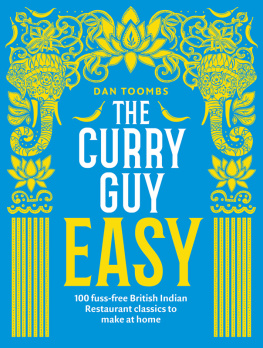


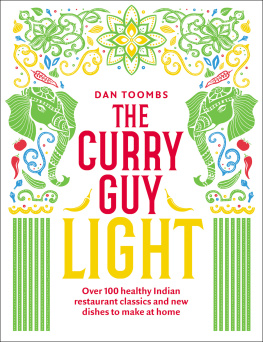



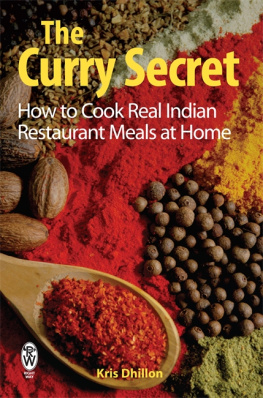
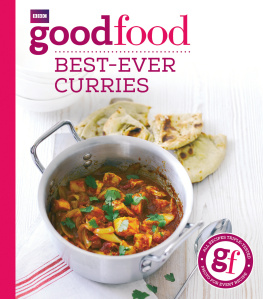
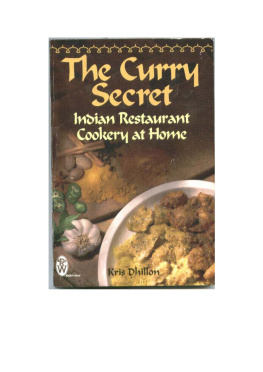
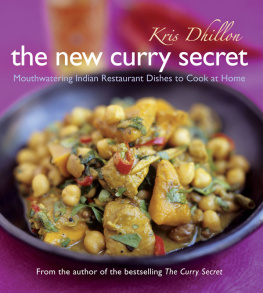
 Kris Dhillon
Kris Dhillon  Constable & Robinson Ltd
Constable & Robinson Ltd